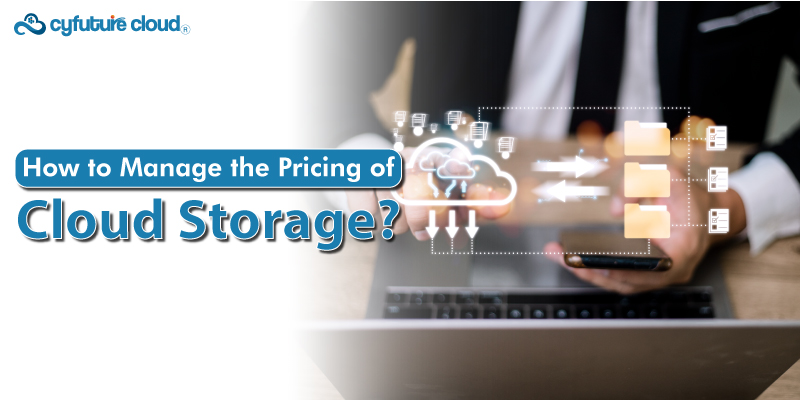 Server
Colocation
Server
Colocation
 CDN
Network
CDN
Network
 Linux Cloud
Hosting
Linux Cloud
Hosting
 VMware Public
Cloud
VMware Public
Cloud
 Multi-Cloud
Hosting
Multi-Cloud
Hosting
 Cloud
Server Hosting
Cloud
Server Hosting
 Kubernetes
Kubernetes
 API Gateway
API Gateway


Cloud storage solutions store, manage and access your data. Cloud storage offers scalability, flexibility, and accessibility. Thus making it the best option for organizations of all sizes.
However, managing cloud storage pricing is crucial for controlling costs and optimizing resource utilization.
This knowledge base will explore various strategies for managing cloud storage pricing to optimize cost.
Let’s get started!
- Cloud Storage Solutions: Businesses from different sectors heavily rely on cloud storage. This reliance arises from the scalability, adaptive nature, and accessibility of cloud storage solutions.
- What are its Benefits: It includes scalability to allow for changing demands on the amount of data that needs to be stored. Flexibility in accessing their data from anywhere they have an internet connection.
- Importance of Pricing Management: Pricing management is essential to cloud storage. It requires effective implementation. Managing costs and maximizing resource utilization keep organizations within their budgetary limits.
- Exploration of Pricing Strategies: This paper discusses several approaches and guidelines on cloud storage pricing management. With the knowledge of these strategies, businesses can effectively manage costs and improve resources.
- Pay-As-You-Go: In this pricing model, users are charged only for what they use. It provides flexibility and cost-effective benefits.
- Subscription-based: This pricing is one in which a monthly or yearly fee is paid for an allotted amount of storage. Also, it offers predictability of costs and applies to businesses with constant storage needs.
- Tiered Pricing: Tiered pricing involves different price tiers, offering various storage levels and features. In addition, users can pick a tier that suits their storage needs and budget limitations.
- Usage-based Models: Pricing in usage-based models is based on the number of data stored and retrieved. This flexible model allows businesses to alter their storage and access needs.
- Considerations in Model Selection: Storage needs, budget limitations, and utility preferences are involved in choosing a pricing model. Enterprises must determine their specific requirements and select a model that provides the best combination.
- Storage Requirements: The pricing of cloud storage is determined by the amount of data that needs to be stored. For companies with more extensive storage needs–costs can be higher than those with smaller demand.
- Rate of Data Transfer: The data transfer rate is the rate at which data can be transmitted in and out of the storage system.
- Access Frequency: The pricing depends on the frequency at which data will be accessed. If data is accessed frequently–it may lead to more costs than if the access is infrequent.
- Geographic Redundancy: Geographic redundancy can involve data replication across multiple geographical locations. This is for backup and disaster recovery purposes. Further resulting in higher pricing tiers due to increased infrastructure costs.
- Additional Features: The pricing may differ depending on the availability of other features. It includes encryption, data deduplication, and versioning. When assessing cloud storage solutions, businesses should consider the value of these features and their prices.
- Assessment for Cost Estimation: It allows users to estimate possible costs and prevent unexpected spending. Businesses should perform comprehensive assessments of their storage requirements and consumption patterns to make well-informed decisions.
- Cloud Cost Management Platforms: The cloud cost management platforms provide visibility into the use of clouds and their expenses, thus allowing companies to control spending by analyzing trends in order to find ways to save. These platforms enable businesses to make the right decisions on resource allocation and optimization.
- Monitoring and Analytics Tools: Businesses can monitor storage resources in real-time to track usage levels, performance metrics as well as cost trends. Enterprises can identify possible opportunities for improvement and make rational decisions about resource allocation.
- Automation and Orchestration Solutions: Cloud storage resources provisioning, deployment and management are simplified through automation and orchestration solutions by removing the manual effort that can cause mistakes. These solutions enable companies to optimize resource utilization and boost the efficiency of their operations.
- Cost Allocation Mechanisms and Chargeback Systems: The cost allocation mechanisms and chargeback systems enable businesses to allocate costs for cloud hosting services according to departments, projects, or customers precisely. With the help of such mechanisms, companies can promote transparency and accountability in cost processes.
- Facilitation of Transparency and Accountability: In a nutshell, these tools and technologies tend to foster transparency and accountability in the cloud storage pricing management process through informed decision-making on behalf of businesses regarding the cost associated with the use of clouds.
By adopting a comprehensive approach to pricing management, businesses can achieve cost optimization and maximize value from their cloud investments.

Let’s talk about the future, and make it happen!
By continuing to use and navigate this website, you are agreeing to the use of cookies.
Find out more


